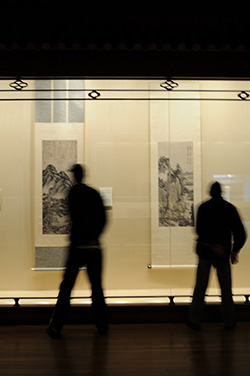Authenticity and connoisseurship
 | |
Academics and market professionals
Academics and market professionals tend to consider attribution and qualitative assessment with slightly different approaches.
Academics largely anchor their knowledge with museum collections, taking these as the reference for looking at unfamiliar pieces. This tends to privilege a relatively narrow set of 'best work' that is regularly published and accessible. 'Secondary' works by major artists are also referenced, though awareness of a wide range of these is sometimes difficult owing the incomplete state of publication of museum collections. A consequence of this is that newly seen works (such as those emerging from private collections) that do not match the characteristics of the best references will be treated with caution and may be avoided in the publication of art historical accounts. Academics are also increasingly attentive to evidential issues and tend to be uncomfortable in judging 'by eye'. On the whole, few academics regularly view auctions, especially the large number now occurring in China.
By comparison, market professionals see a wider qualitative range of art. Rather like traditional Chinese collectors, they tend to hold to a looser understanding of the work identified with any particular figure. Attribution is appreciated as one aspect of qualitative assessment. In the market it may be less significant to distinguish between a secondary work that is well-associated with a master and a good work of the master's student – in both cases the work is 'average' and will be priced accordingly. At the top of the market, experienced professionals undertake research in museum collections, accumulating viewing experience of dispersed and unpublished works.
There is competition and overlap between academic and market-centred approaches. Everyone is interested in attribution, though with differing emphases, and methodological concerns. Academics tend to favour strict chains of transmitted ownership and privilege documents relating to origins, while market professionals will give rather more weight to the views of well-regarded collectors of recent centuries who have owned of commented on a work.
Academics largely anchor their knowledge with museum collections, taking these as the reference for looking at unfamiliar pieces. This tends to privilege a relatively narrow set of 'best work' that is regularly published and accessible. 'Secondary' works by major artists are also referenced, though awareness of a wide range of these is sometimes difficult owing the incomplete state of publication of museum collections. A consequence of this is that newly seen works (such as those emerging from private collections) that do not match the characteristics of the best references will be treated with caution and may be avoided in the publication of art historical accounts. Academics are also increasingly attentive to evidential issues and tend to be uncomfortable in judging 'by eye'. On the whole, few academics regularly view auctions, especially the large number now occurring in China.
By comparison, market professionals see a wider qualitative range of art. Rather like traditional Chinese collectors, they tend to hold to a looser understanding of the work identified with any particular figure. Attribution is appreciated as one aspect of qualitative assessment. In the market it may be less significant to distinguish between a secondary work that is well-associated with a master and a good work of the master's student – in both cases the work is 'average' and will be priced accordingly. At the top of the market, experienced professionals undertake research in museum collections, accumulating viewing experience of dispersed and unpublished works.
There is competition and overlap between academic and market-centred approaches. Everyone is interested in attribution, though with differing emphases, and methodological concerns. Academics tend to favour strict chains of transmitted ownership and privilege documents relating to origins, while market professionals will give rather more weight to the views of well-regarded collectors of recent centuries who have owned of commented on a work.
- Page 1
- 2



